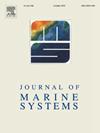Coastal zooplankton in the Palmer Archipelago, Western Antarctica Peninsula: Influence of environmental conditions at short-term scale during austral summer
IF 2.5
3区 地球科学
Q2 GEOSCIENCES, MULTIDISCIPLINARY
引用次数: 0
Abstract
Seasonal and inter-annual fluctuations in the zooplankton composition and abundance from West Antarctica are relatively well known. Nonetheless, there is scarce information about the zooplankton structure in Antarctic waters at shorter time and spatial scales. In this study, we analyzed short-term (i.e., days) temporal and spatial (i.e., km) variation in mesozooplankton from a shallow embayment (South Bay, Doumer Island, 64°52′S, 63°35′W) and surrounding zones off the Western Antarctic Peninsula (WAP), during the austral summer 2022. A total of 110 taxonomic groups were identified in the samples. Meroplankton (Asteroidea, Polychaeta, and Nemertea larvae) was more abundant inside the bay, while the opposite trend was observed for the holoplankton (Copepoda, Appendicularia, and Chaetognatha). Copepods numerically dominated the samples, particularly Oithona spp., Calanoides acutus, and Paraeuchaeta sp. Only meroplankton showed significant differences in the composition and abundance between zones, although alpha-diversity indices showed similar values inside and outside the bay. A Multivariate Regression Tree indicated that the pH (node 1) was the primary predictor separating zooplankton assemblages, followed by the east–west wind stress (Tau-U, node 2), and water stability (node 3). This study highlights the importance of shallow bays in the WAP for the aggregation of planktonic stages of benthic and demersal taxa.
南极半岛西部帕尔默群岛沿海浮游动物:南部夏季短期尺度环境条件的影响
南极洲西部浮游动物组成和丰度的季节性和年际波动是相对众所周知的。然而,在较短的时间和空间尺度上,关于南极水域浮游动物结构的信息很少。在这项研究中,我们分析了在2022年南方夏季,在南极半岛西部(WAP)附近的一个浅海湾(南湾,杜默岛,64°52'S, 63°35'W)及其周围区域中浮游动物的短期(即天)时空(即公里)变化。共鉴定出110个分类类群。海湾内浮游生物(星形纲、多毛纲和内毛纲幼虫)数量较多,而全浮游生物(桡足纲、尾毛纲和毛纲)数量则相反。在数量上,桡足类占主导地位,尤以Oithona spp、Calanoides acutus和Paraeuchaeta sp.居多。只有浮游生物的组成和丰度在不同区域间存在显著差异,但湾内和湾外的α -多样性指数基本一致。多元回归树表明,pH值(节点1)是区分浮游动物群落的主要预测因子,其次是东西风应力(节点2)和水稳定性(节点3)。本研究强调了WAP中浅海湾对底栖和底栖分类群浮游阶段聚集的重要性。
本文章由计算机程序翻译,如有差异,请以英文原文为准。
求助全文
约1分钟内获得全文
求助全文
来源期刊

Journal of Marine Systems
地学-地球科学综合
CiteScore
6.20
自引率
3.60%
发文量
81
审稿时长
6 months
期刊介绍:
The Journal of Marine Systems provides a medium for interdisciplinary exchange between physical, chemical and biological oceanographers and marine geologists. The journal welcomes original research papers and review articles. Preference will be given to interdisciplinary approaches to marine systems.
 求助内容:
求助内容: 应助结果提醒方式:
应助结果提醒方式:


